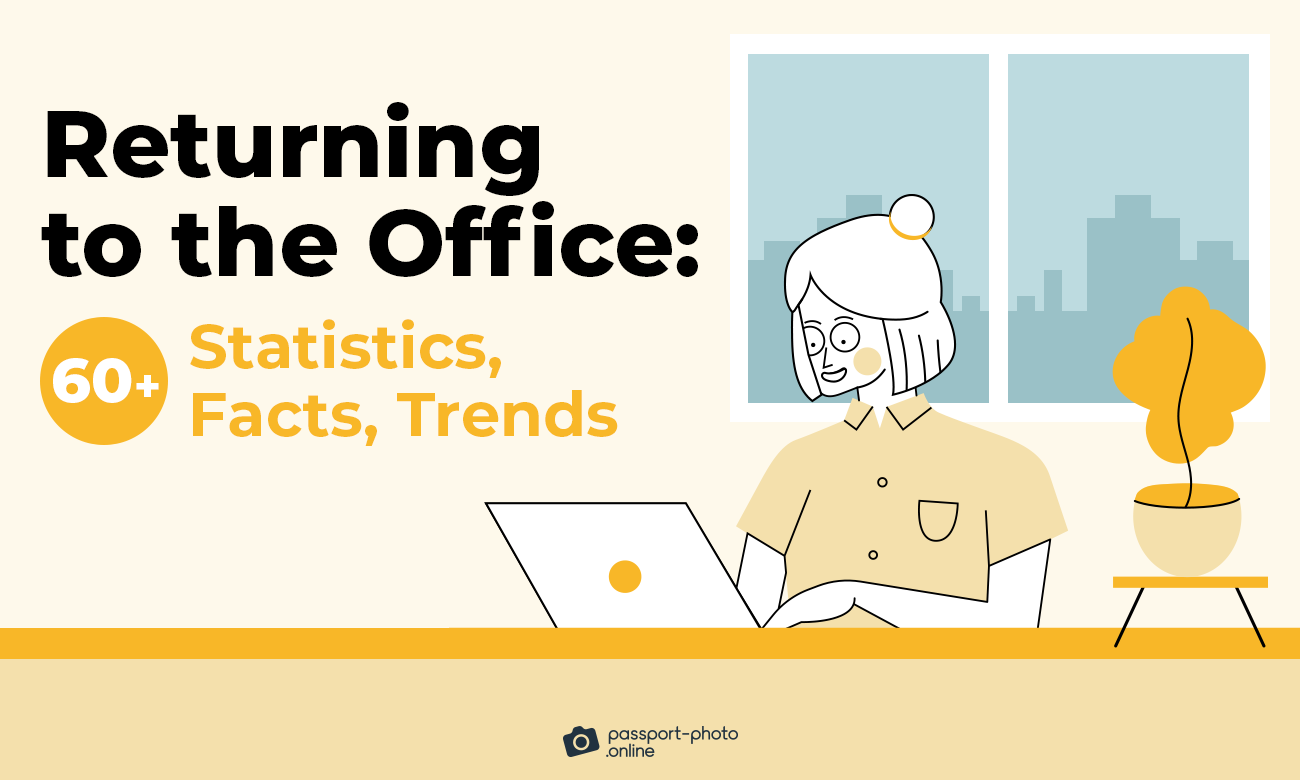For most of us, remote work is a mixed bag.
On the one hand, we can roll out of bed and work in our PJs. No more commuting or expensive office lunches.
But—
Working from home can also be lonely and distracting. After all, it’s hard to stay focused around an attention-hogging pet, YouTube, or that never-ending load of laundry.
That’s why at Passport Photo Online, we’ve decided to put together a data-driven roundup of the most recent and valuable stats, facts, and trends around US employees’ return to the office for 2023.
Let’s dive in.
Top 10 Return to the Office Statistics and Facts to Know in 2023
- 61% of workers want to work remotely indefinitely.
- Roughly six in 10 employees are more likely to apply for a job with a remote work option.
- 61% of Americans would expect a pay raise if their employer no longer allowed them to WFH.
- 49% of employees are worried that returning to the office could hurt their work-life balance.
- 34% of US workers returned to the office full-time in 2022.
- 40% of employees that still work remotely at least once a week claim they’d quit if their employer mandated a full-office return.
- 77% of managers in the US are ready to fire, cut pay, or limit promotion opportunities for staffers that don’t comply with return-to-office mandates.
- Yet, 43% of employees said nothing happened when they worked in the office fewer days than requested.
- 51% of workers that still WFH said their bosses had announced a plan to return to the brick-and-mortar office.
- 75% of managers want employees back in the office, citing a loss of company culture, potential lack of focus, and productivity as the key reasons to return.

Looking for passport photos? Discover more information:
How Workers Feel about Returning to the Office
- 55% of workers want to work from the office fewer than three days per week.
- When and why to come into the office has been the biggest challenge for 38% of hybrid employees.
- 44% of executives want to come back to the office every day, but only 17% of regular employees would follow suit.
- 72% of staffers prefer a hybrid remote-office model.
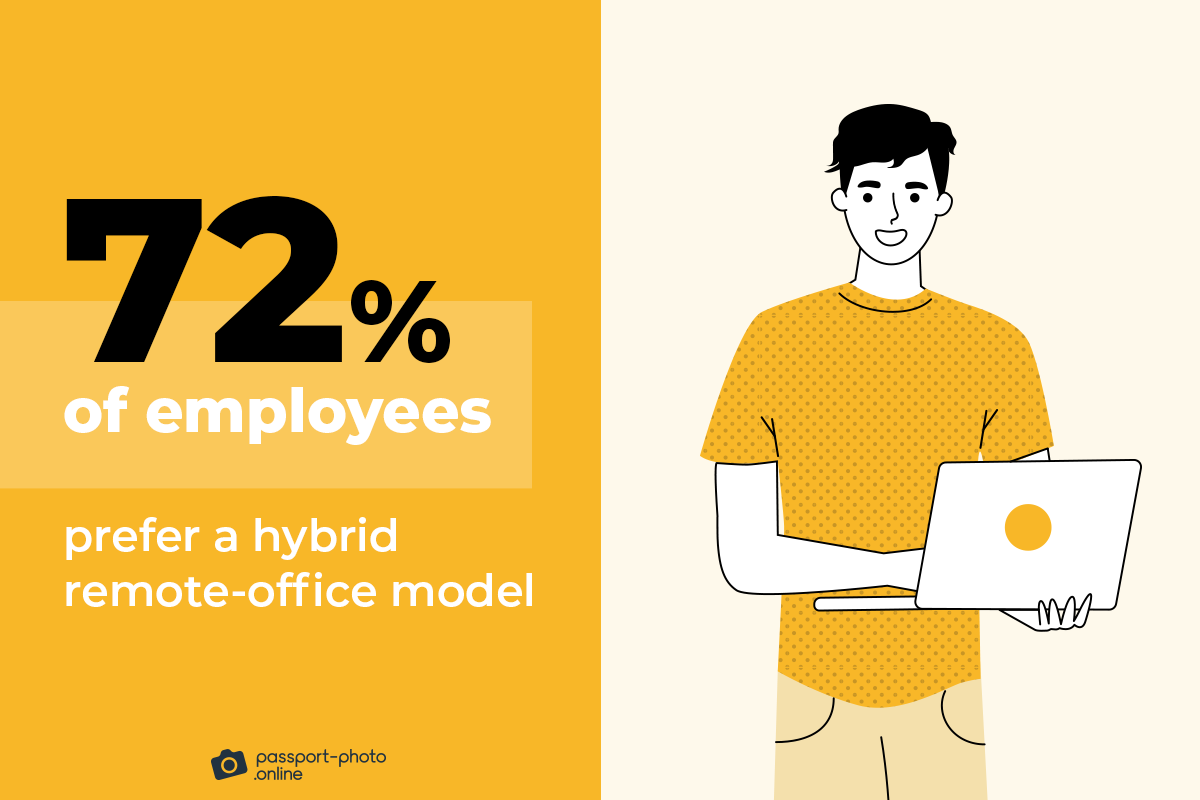
- 49% of workers are anxious to return to the office due to the associated costs of the commute or food.
- 37% of working professionals feel more anxious, worried, and stressed when they go into the office.
- Over half of fully in-person office workers (55%) would prefer a more flexible work arrangement.
- 58% of women want to work in a hybrid or remote setting at least three days a week compared to 48% of men.
- 64% of the global workforce has already searched or would consider searching for a new job if their boss wanted them back in the office full-time.
- Over 75% of employees have found simple pleasures in working from home, such as:
| Remote Work Perks | Share |
|---|---|
| More frequent coffee or snack breaks | 54% |
| Extra time with family | 51% |
| Casual dress code | 50% |
| More comfortable seating | 50% |
- Tech or computer science employees are the most excited about a hybrid role (50%). In contrast, arts and entertainment workers would rather be fully in-office (54%).
- While 67% of remote and hybrid Americans intended to return to the office in 2022, only 13% said they’d go back five days per week.
- Just 5% of individual contributors that have been working from home will go into the office every day. When it comes to senior leaders, that number jumps to 24%.
- Half as many women as men will return to the office five days a week: 9% vs. 18%.
- When it comes to remote and hybrid employees that already have the option to work in the office, the main reasons to stay home are:
| Key Reasons to Work from Home | Share |
|---|---|
| Improved productivity | 17% |
| Not having to commute | 17% |
| Lack of an actual need to go into the office | 15% |
| Not having anyone else in the office | 6% |
- 40% of staffers are comfortable returning to the office now, whereas 18% don’t want to go back no matter what.
- 25% of Americans would return to the office if everyone were vaccinated. 15% would come back if they got a raise, and the remaining 10% would no longer WFH if the office offered a better working environment.
- Over half of hybrid employees (51%) are considering switching to remote work.
- Roughly 71% of Gen Zers (aged 18–24) would consider looking for a new job if their employer insisted on returning to the office full-time. In contrast, only 61% of 35-to-44-year-olds and 56% of 45-to-54-year-olds would follow suit.
- Just 13% of executives are willing to let go of the office forever.
- For 87% of employees, the office is essential for collaborating and building relationships with team members.
- Newbie employees (with 0–5 years of experience) are more likely to want to be in the office more often: 30% of them like to WFH no more than one day per week vs. just 20% of all respondents.
- The least experienced working professionals are more likely to feel less productive when they work from home than their more experienced colleagues (34% vs. 23%).
- 52% of fully remote workers are very satisfied with their jobs, compared to 40% of employees working mainly from the office.
- 68% of in-person workers consider their job very meaningful, compared to 60% of remote or mostly remote workers and 54% of employees who work primarily in-person.
- 52% of staffers expect in-person workers to have better career opportunities than remote workers.
- Only 3% of workers want to return to the office five days a week.
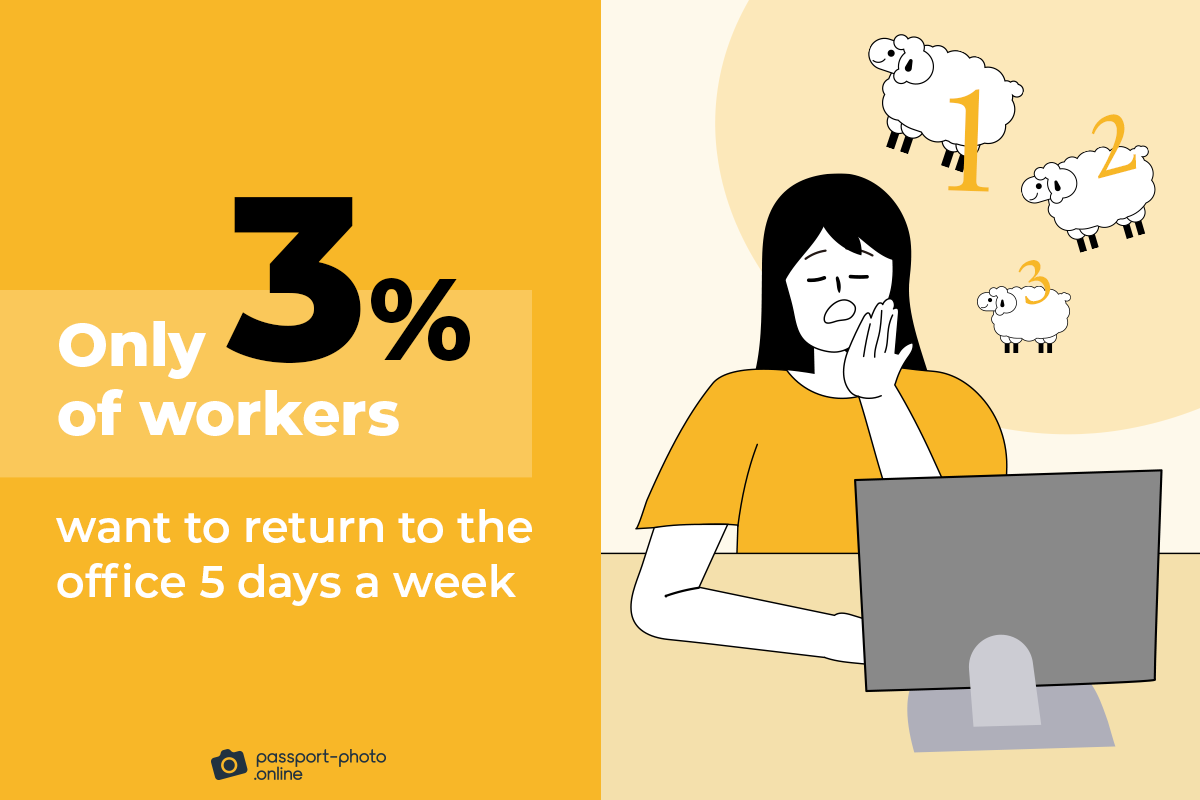
- 86% of employees want to WFH at least two days a week.
- 21% of working professionals don’t see themselves returning to the office.
- 66% of staffers say making small talk with coworkers they haven’t seen in person for some time gives them anxiety.
- 60% of employees wish they could permanently work from home to avoid social awkwardness.
- 61% of Americans working from home will remain in the remote capacity, with 64% citing an improved work-life balance.
- 17% of remote workers have relocated and can no longer reach the office quickly.
Employers’ Take On Heading Back to the Workplace
- Only 4% of companies have made everyone return to the office full-time.
- 90% of companies have allowed hybrid work schedules.
- 50% of leaders say their organization requires or plans to require workers to return to the office full-time in the next year.
- Just 28% of decision-makers have defined why and when to go to the office.
- 60% of managers agree or strongly agree that a full-time return to the office will occur shortly.
- 28% of businesses have decided who should work from where.
- 75% of executives anticipate that at least half of all their employees will work from the office.
- 68% of executives believe regular employees should be in the office at least three days a week to maintain a company culture.
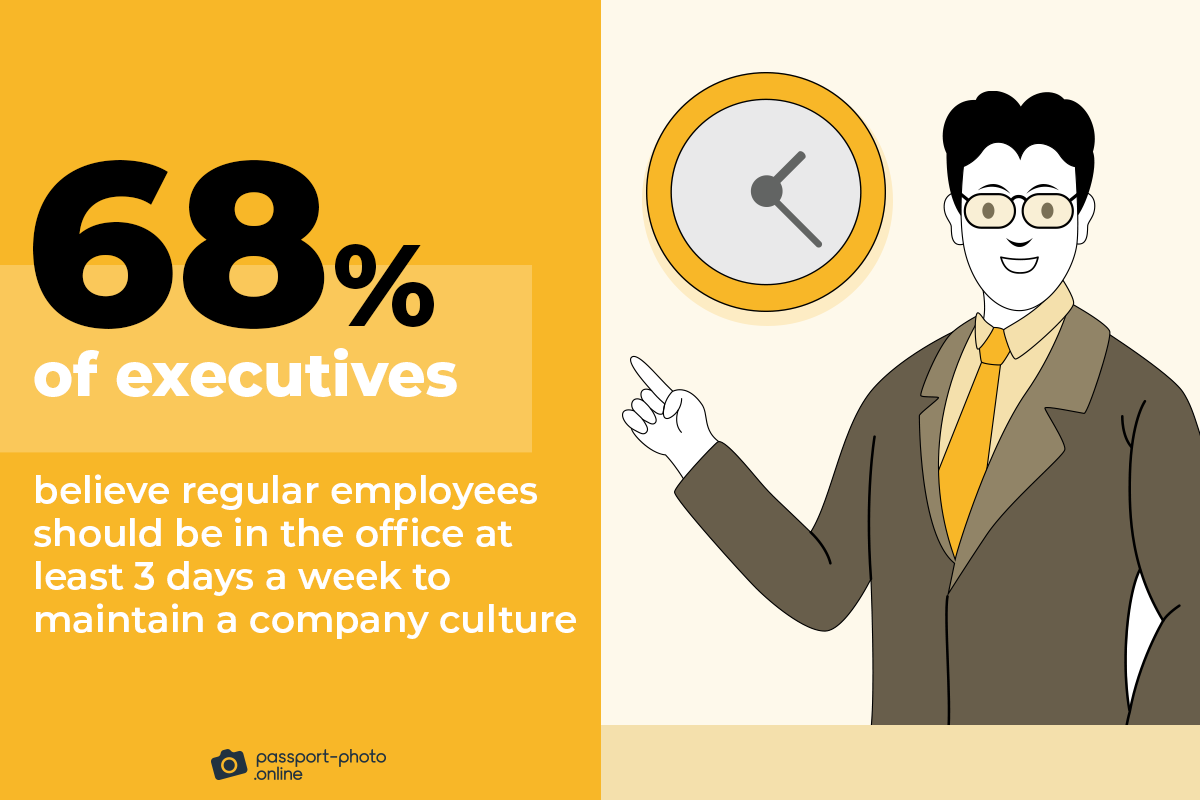
- 65% of leaders believe the office is “very important” to improving employee productivity, and a little over 50% consider it very important for collaboration.
- Just 15% of workplace leaders have rolled out a 100% in-office requirement for staff.
- 56% of organizations have a hybrid at-will policy. That means employees pick when they come into the office.
- 88% of companies use incentives to get employees back on-site, and 85% of them think they are working. The incentives are as follows:
| Employers’ Incentives to Get Employees Back in the Office | Share |
|---|---|
| Food and beverage programs | 56% |
| Social events | 42% |
| Company events | 41% |
| Improved or new furniture and amenities | 40% |
| Revamped office environment (e.g., occasional social games) | 39% |
- Only 24% of executives expect many or all office employees to WFH for a significant amount of time.
- 69% of managers have difficulty managing remote employees and are now experiencing burnout with remote management.
- 51% of managers believe their organizations would consider pay cuts for those that refuse to return to the office.
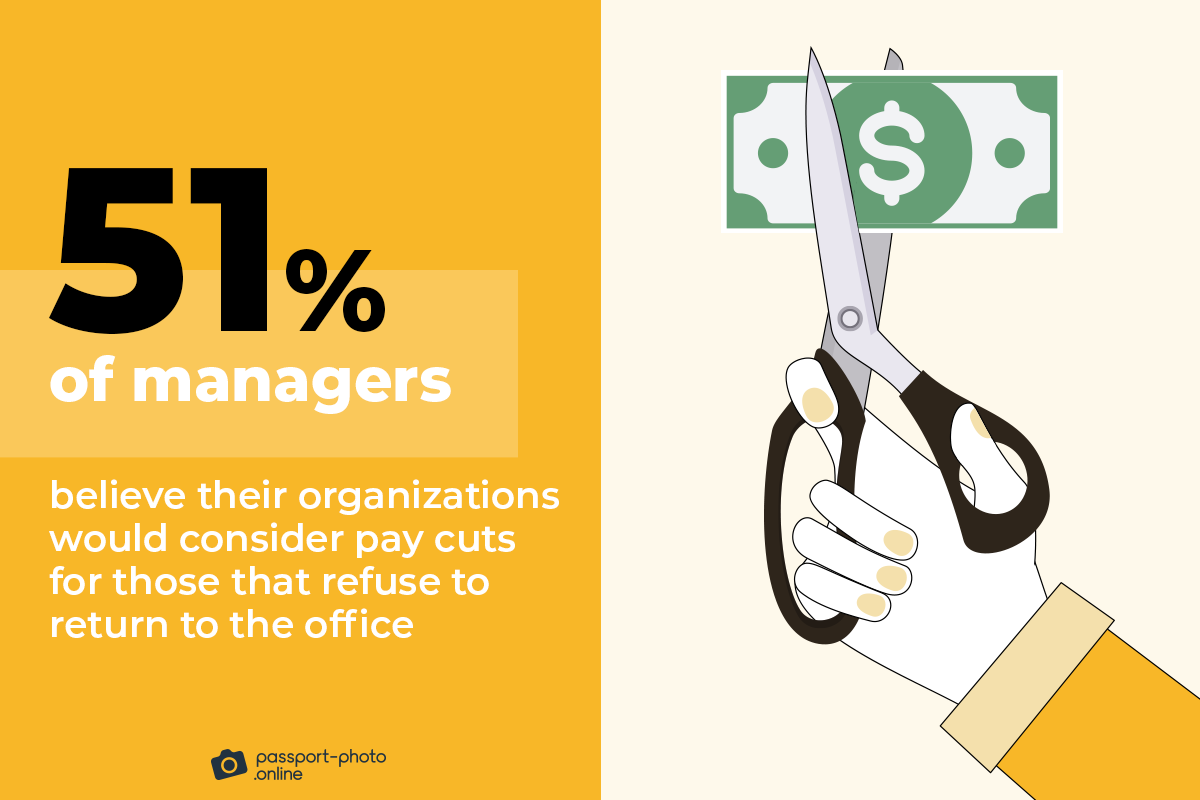
- Roughly 44% of the companies require workers to return to the office at least part-time.
Stacking It All Up
There you have it.
A comprehensive list of statistics, facts, and trends around employees’ return to the office for 2023.
Let us know in the comments if there are any other stats you’d like to see.
FAQ
What percentage of employees want to return to the office?
How do employees feel about returning to the office?
Who’s most desperate to return to the office?
Can you be fired for refusing to return to the office?
Why do companies hate working from home?
How do you encourage staff back to the office?
Why do employees not want to return to work?
Fair Use Statement
Did you like our infographics? If so, feel free to share them with your audience. Just remember to mention the source and link back to this page.
Sources
- Apollo Technical, “Statistics on Remote Workers That Will Surprise You (2022)”
- Barrero M., Bloom N., Davis S., “Why Working from Home Will Stick”
- Berger C., “A Huge Number of Employees Are Rebelling against In-Office Mandates. The Battle Is Just Beginning”
- Business Wire, “Two-Thirds of Remote Workers Are Planning to Go Back to the Office – But Not Every Day, Qualtrics Study Shows”
- Envoy, “At Work: The 2022 Workplace Trends Report”
- Erickson R., Cohen D., Ray R., “The Reimagined Workplace Two Years Later”
- Frontier, “How Employees Feel about Returning to the Office”
- Future Forum, “Future Forum Pulse Summer Snapshot”
- Future Forum, “Inflexible Return-To-Office Policies Are Hammering Employee Experience Scores”
- HiBob, “Coming Back to the Office Survey”
- Javed S., “Employees Still Reluctant to Return to the Office, Study Finds”
- Kolakowski N., “Workers Really Don’t Want to Return to the Office Full-Time: Poll”
- Korolevich S., “The Great Return: Survey Of Managers Reveals Return To Office Battle In 2022”
- McKinney J., “New Poll: About 90% Of Americans Are Ready to Return to the Office and Stop Working Remotely”
- Microsoft, “Great Expectations: Making Hybrid Work Work”
- Molay A., “Momentive Workforce Happiness Index: May 2022”
- Morning Consult, “Tracking the Return to Normal: Work & Offices”
- Pew Research Center, “COVID-19 Pandemic Continues To Reshape Work in America”
- PwC, “US Remote Work Survey”
- Rippling, “Employee Expectations after 2 Years of Working from Home”
- Shaw W., “Just 3% of White Collar Workers Want a Full Office Return”
- Sherman A., “Making Sense of Why Executives Are Eager to Get Employees Back in the Office”
- Smith M., “64% Of Workers Would Consider Quitting If Asked to Return to the Office Full-Time”

As a Digital PR specialist and a member of the Society of Professional Journalists (SPJ), Max has 5+ years of writing experience.
Over the course of his career, Max’s work has garnered significant attention, with features in numerous prominent publications such as The New York Times, Forbes, Inc., Business Insider, Fast Company, Entrepreneur, BBC, TechRepublic, Glassdoor, and G2.
